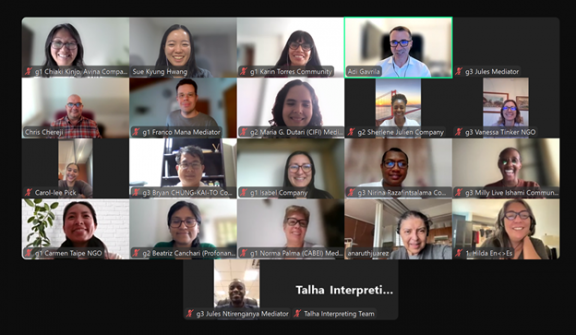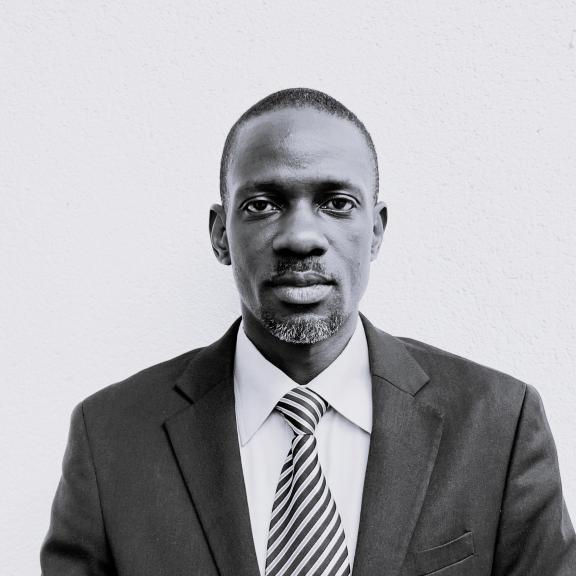Tackling grievances: A virtual training on company-community mediation
The Green Climate Fund (GCF) provides developing countries with funds for projects or programmes to mitigate and adapt to climate change through Accredited Entities (AE). AEs and delivery partners work directly with developing countries on project design and implementation.
However, even the best-designed projects can have unintended consequences. Individuals or communities who believe they are negatively affected or may be affected by projects funded by GCF may file a complaint with the Independent Redress Mechanism (IRM) or the Grievance Redress Mechanism (GRM) of the AE. To build the capacity of GCF DAEs to handle project-related grievances, in alignment with international standards and best practices for GRMs, the IRM is mandated to offer a range of capacity building training opportunities to Direct Accredited Entities (DAEs).
As an IRM intern passionate about and supporting dispute resolution, I was granted an opportunity to participate in an enriching virtual company-community mediation training. I am delighted to share some key insights from the experience. This “mediation training” is a continuation of IRM’s “operating an effective GRM” training. The IRM offered virtual training on company-community mediation for the fourth time. This training was designed for GCF Direct Access Entity (DAE) staff overseeing their respective GRMs. The five-week training, which included five live sessions, took place from September 20th to October 18th, 2024.
The course's primary objective was to enhance GRM DAE staff's capabilities in effectively diagnosing, understanding, and resolving grievances stemming from conflicts among project stakeholders. Under the expert guidance of Mr. Constantin-Adi Gavrilă, CEO and founder of ADR Center Romania, and Dr. Christian Radu Chereji, a professor of conflict studies at Babeș-Bolyai University in Cluj, Romania, the course focused on designing and implementing mediation processes to facilitate conflict resolution.
The training was designed with various interactive activities, including a pre-entry and exit quiz, written assignments, recorded assessments, and live role-playing exercises at various stages of the company-community mediation process structure: preparation, problem exploration, solution development, and agreement and closure (PESA). This year, facilitators introduced a competency framework to assess participants' capacities prior to the training.
They also introduced a new fictional case study on Energy Renaissance International, which successfully sought and obtained matching funds to develop a wind farm in the Moon Mountains. An agreement was reached with the government of Kadaroa to establish and manage the wind farm, aiming to provide affordable and sustainable energy to the nation. However, it became evident that the plan did not adequately consider the rights and livelihoods of the indigenous Assram tribe. Considering this oversight, the Kadaroa Human Rights Association respectfully submitted a complaint to the IRM on behalf of the Assram tribe, alleging loss of livelihood, property damage, violence, threats of removal, environmental degradation, and potential displacement from their ancestral lands. Facilitators skillfully employed this engaging case study to enhance the mediation training experience.
Session One: Introduction to Company-Community Mediation
Following a thoughtful introduction of each participant, facilitators Adi and Chris guided the group in exploring the concept of company-community disputes through a reflective examination of relevant case studies. We engaged in a meaningful discussion about the role of mediation in resolving these conflicts, highlighting the advantages of mediation in company-community situations and key concepts essential to effective mediation practices. I observed a strong consensus among participants about the benefits of mediation, particularly in restoring relationships and empowering parties to control outcomes.
Session Two: Conflict Analysis and Communication Skills
In the second session, we explored various models and techniques for conflict analysis. We delved into each party's diverse interests and concerns and the cultural, environmental, and social factors that shape these disputes. A significant emphasis was placed on managing challenging dialogues and fostering effective communication. In our plenary discussions, participants highlighted impartiality as one of the most essential skills for a mediator, as it greatly contributes to de-escalating conflicts. One of my standout moments was a brain teaser during the breakout session that focused on handling emotions during meditation. As part of our assignment, we were tasked to record video role-plays in small groups where we would act as mediators preparing for an initial joint mediation session. Our task was to create a flexible agenda and formulate questions to help frame the issues for mediation in the fictional Karadoa case study.
Session Three: Mediation Techniques and Strategies – Preparing for Mediation
Through role-playing based on a preliminary meeting designed to prepare for the initial joint mediation session, we had the opportunity to navigate typical challenges associated with mediation preparation. I really appreciated the breakout rooms where we learned how to choose the language used to describe a conflict in a way that would not offend either party as a mediator. I discovered that using neutral language to present the conflict helps minimise the company's defensiveness, fosters flexibility in perspectives among the affected community, and enhances the trust in the mediator. As part of our assignment, we engaged in video role-plays in small groups, assuming various roles such as mediators, company representatives, and community representatives. As a community representative with a defined position, I encountered defensiveness from the company representative, who was understandably concerned about protecting the company's reputation. I discovered that when the mediator employed effective communication, the joint meeting became a powerful demonstration of our shared purpose.
Session Four: Mediation Techniques and Strategies – Mediation Sessions
Session four proved to be both enlightening and engaging. The discussion focused on the critical need for mediators to maintain neutrality and impartiality throughout the mediation process and self-assessment for mediators. Facilitators organised breakout rooms where we participated in role-playing exercises to help us better understand the complexities inherent in joint mediation sessions. This experience allowed me to witness how deadlocks can occur, particularly due to power imbalances among the parties involved. I recognised mediators' valuable role in providing capacity-building support to the less powerful party, fostering the exploration of effective and sustainable outcomes. We were assigned various roles (mediator, company representative, and community representative) for our last assignment. Each of us engaged in private meetings with the assigned mediators to collaboratively generate the initial draft of the mediation agreement. The mediators effectively coordinated a series of private discussions with all parties involved in the conflict, guiding us toward a mutually acceptable resolution.
Session Five: Closure and Ethical Considerations
The fifth and final training course session underscored the significance of ethics, the signing of a settlement agreement, and the conclusion of the Kadaroa case. During this session, we engaged in role-playing activities designed to collaboratively refine a settlement agreement that harmonised the interests of both the company and the community within designated breakout rooms. As a representative of the community in this role-play, I took the opportunity to discuss and negotiate certain modifications to provisions in the agreement after thorough consultations with community members before signing the agreement. A particularly thought-provoking moment arose when we reconvened from the breakout rooms, and the facilitator presented an intriguing ethical scenario: What actions would you take as a mediator if the CSO made the settlement agreement public on a social media platform before the involved parties had formally signed it? This compelling question inspired us to incorporate important clauses about confidentiality breaches into the agreement.
Fellow participant, Bryan CHUNG-KAI-TO, Operation and Finance Coordinator, Indian Ocean Commission, shared his perspective on the training:
“Since we are newly accredited to the GCF, we now have a deeper understanding and are better equipped to integrate the mediation process into our projects. The knowledge gained from this course will enable us to approach conflicts with greater confidence, applying effective strategies for resolving issues and fostering collaboration.”

Overall, integrating the PESA structure into the mediation process significantly enhanced the coherence of the company-community mediation training. This training was both memorable and rewarding. It improved my knowledge and skills in conflict analysis and planning a structured mediation process. I can now apply this knowledge and experience to better support the IRM’s dispute resolution team. I appreciate the IRM and our facilitators, Adi and Chris, for their invaluable effort in making it a success.
----
This blog was written by Oscar Nuwagaba, IRM intern.
